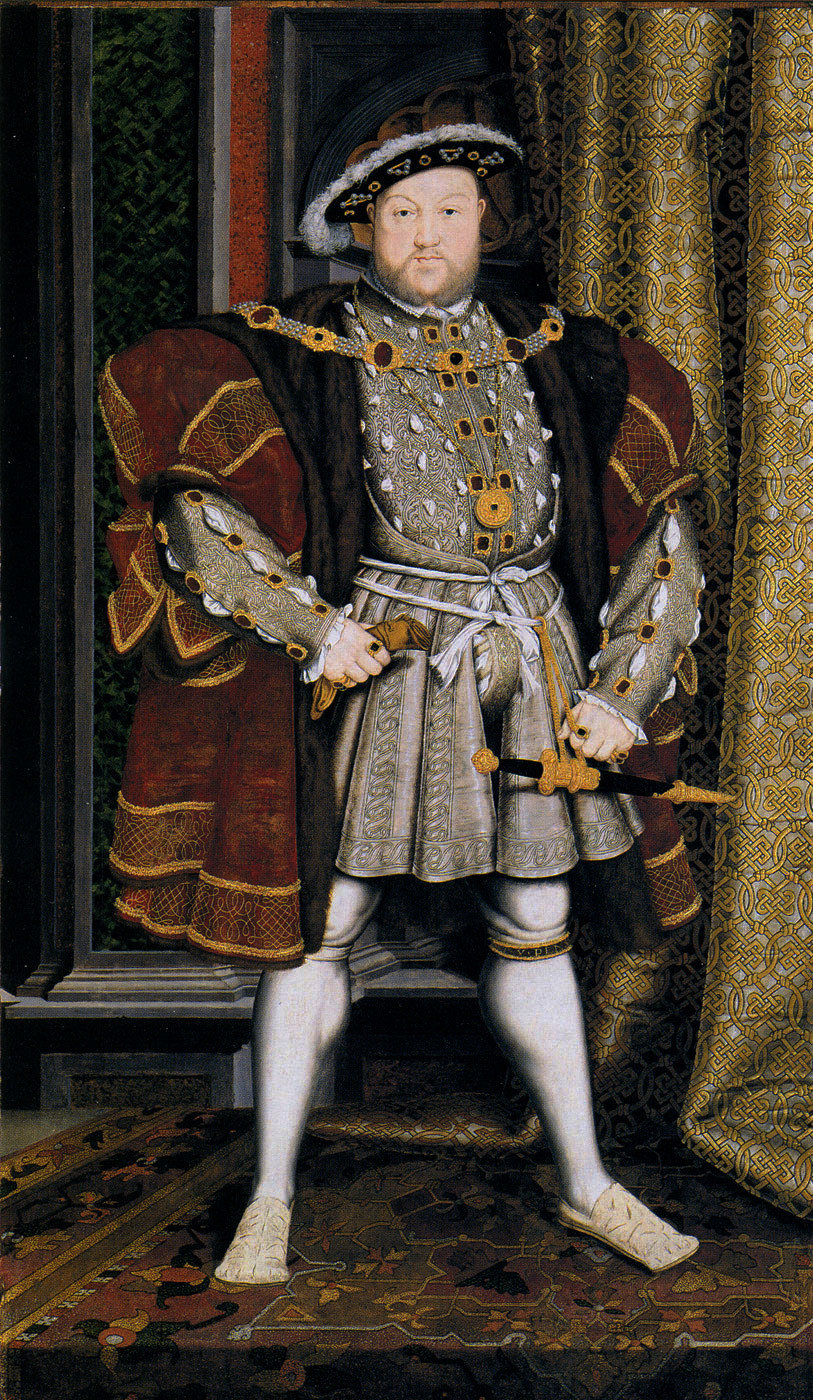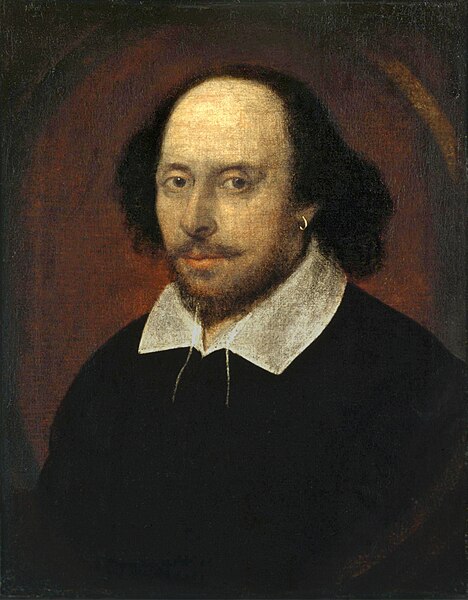Do you know the English king Henry VIII? Yes, yes. The chap who tore England away from the influence of Vatican? Well, the classical music piece that I am going to discuss today is based on an English folk song and a tune which is widely believed by many to be a composition of England’s most known and arguably the most controversial king.
එංගලන්තයෙ රජ කළ 8වෙනි හෙන්රි රජු ගැන ඔබ දන්නවා ද? ඔව්, ඔව්. වතිකානුවෙන් එංගන්ත සභාව වෙන් කළ පුද්ගයා තමයි ඒ. අද මම විස්තර කරන්නට යන සම්භාව්ය සංගීත නිර්මාණය පදනම් වෙලා තියෙන්නේ 8වෙනි හෙන්රි රජු රචනා කළා යැයි සැලකෙන ඉංග්රීසි ජන ගීයක් හා එහි තනුව මතයි.
 |
| King Henry VIII (Source: http://bit.ly/fTsaE8) |
Henry’s brother Prince Arthur was married to Catherine of Aragon; a political marriage to keep peace between Spain and Britain. But soon after the marriage Arthur died and the ruling dynasties, still wanting the peace to be kept, made Henry to marry Catherine. For this marriage to take place, the pope Julius II issued a papal dispensation saying that the passage Leviticus 20:21 which prohibits the marriage of a man to his brother's widow is not applicable for this marriage. However it is a well known fact that Henry has been in love with Catherine’s maid of honour Anne Boleyn since 1525. But Anne had rejected the king’s love. This song is said to be written at that time to Anne by the king.
හෙන්රි කුමාරයාගේ සහෝදරයා වුනු ආතර් කුමාරයා විවාහ වෙලා හිටියේ ස්පාඤ්ඤ කුමාරියක් වුනු ඇරොගන් හි කැතරින් කුමරියත් සමඟයි. මේ විවාහය ස්පාඤ්ඤය හා එංගලන්තය අතර සාමය රැකීම සඳහා කරපු දේශපාලන විවාහයක්. නමුත් ආතර් කුමාරයා විවාහවී සුළු කාලයකින් මරණයට පත්වුනා. ඒ විවාහය නිසා රටවල් දෙක අතර ඇතිව තිබුණු සාමය පවත්වා ගන්න ආතර්ගේ සහෝදරයා වුනු හෙන්රිට කැතරින්ව විවාහ කර දුන්නා. (නමුත් සහෝදරයාගේ වැන්දඹු භාර්යාව හා විවාහ වීම බයිබලයේ Leviticus 20:21 හි තහනම් කර තිබෙන නිසා එකල සිටි දෙවන ජුලියස් පාප්තුමා විශේෂ නියෝගයක් නිකුත් කර මේ විවාහය සඳහා ඒ ඡේදය අදාල නැති බව ප්රකාශයට පත් කළා.) හෙන්රි කැතරින්ගේ පරිවාර කාන්තාවන්ගෙන් අයෙක් වූ ඈන් බෝලීන් සමඟ ආදරයක් ගොඩනඟා ගැනීමට 1525 සිටම උත්සාහගත් බව ප්රසිද්ධ කරුණක්. කෙසේවෙතත් ඈන් මුල් කාලයේ රජුගේ ආදරය ප්රතික්ෂේප කළා. බොහොදෙනා විශ්වාස කරන පරිදි හෙන්රි රජු මේ ගීය රචනා කර ඇත්තේ එම කාලයේදීයි.
“Alas, my love, you do me wrong,to cast me off discourteously:For I have loved you for so long,
Delighting in your company.
Chorus:Greensleeves was all my joyGreensleeves was my delight,Greensleeves was my heart of gold,And who but my lady greensleeves.
Your vows you've broken, like my heart,
Oh, why did you so enrapture me?
Now I remain in a world apart
But my heart remains in captivity.
(Chorus)
If you intend thus to disdain,
It does the more enrapture me,
And even so, I still remain
your lover in captivity.
(Chorus)
Well, I will pray to God on high,
that thou my constancy mayst see,
And that yet once before I die,
Thou wilt vouchsafe to love me.
(Chorus)
Ah, Greensleeves, now farewell, adieu,To God I pray to prosper thee,For I am still thy lover true,Come once again and love me.”
 |
| Queen consort Anne Boleyn (Source: http://bit.ly/gU62c4) |
Finally Anne yielded to the King’s advances and fell in love with him. In 1533 Henry declared that no Pope had the right to overrule a Biblical book and declared his marriage to Catherine to be void and married Anne in a secret ceremony, on 25 January 1533. This subsequently led to the great political and religious battle that tore England away from the Catholic church and made way to the establishment of the Anglican church which had the English monarch as the highest religious officer.
කාලයක් ගතවීමෙන් පසුව ඈන් කුමරියත් රජුට ආදරය කරන්න පටන් ගත්තා. 1533දී රජු විශේෂ ප්රකාශයක් නිකුත් කළා බයිබලයේ ඇති කරුණු වෙනස් කිරීමට පාප්තුමාටවත් අයිතියක් නැති බව සඳහන් කරලා. ඒ අනුව කැතරින් හා තමන් අතර සිදුවුනු විවාහය බල රහිත බව ඔහු ප්රකාශ කළා. 1533 ජනවාරි 25 වෙනිදා හෙන්රි රජු හා ඈන් බෝලීන් පෞද්ගලික උත්සවයක් පවත්වා විවාහ වුනා. මේ සිද්ධීන් වතිකානුව හා එංගන්තය අතර ඇති සබඳතා නරක අතට හැරවූවා. එයින් ඇතිවූ ආගමික හා දේශපාලන ගැටුම් කොතරම් උග්ර වුනාද කියනවා නම් අවසානයේ කතෝලික පල්ලියෙන් සම්පූර්ණයෙන්ම ඉවත් වුනු එංගලන්ත සභාව, ඉංග්රීසි රජු ඉහළම ආගමික නිලධාරියා වන ඇංග්ලිකන් ආගම නිර්මාණය කළා.
The embedded YouTube clip features the folk song GreenSleeves (Unaltered tune). The video footage is from the TV series “The Tudors” which is based on the life of King Henry VIII. The scenes highlight the affair between the king and Anne. From 1:09 to 1:15 you can see the marriage ceremony for the king and Catherine.
මේ සමඟ දක්වා ඇති YouTube සල දසුනේ තිබෙන්නේ වෙනස් නොකරන ලද ජන ගීයයි. එහි ඇති රූප රාමු ගෙන ඇත්තේ හෙන්රි රජු හා ඔහුගේ පවුලට සම්භන්ධ සිදුවීම් ඇසුරින් නිර්මාණය කරන ලද The Tudors නම් ටෙලිනාට්යයෙන්. ඈන් හා හෙන්රි රජු මුලු සල දසුන පුරා දැකිය හැකි අතර 1:09 සිට 1:15 දක්වා කැතරින් කුමරිය හා හෙන්රි රජු අතර විවාහ උත්සවය දැකගත හැකියි.
Four hundred years later, in 1934, the renowned English composer Ralph Vaughan Williams (12 October 1872 – 26 August 1958); who is well known for his efforts to collect, preserve and advance English folk music; adapted the tune and wrote the classical piece “Fantasia on Greensleeves".
හෙන්රි රජුගේ කාලයෙන් අවුරුදු හාරසියයකට පසු එනම් 1934දී සුප්රසිද්ධ ඉංග්රීසි ජාතික සංගීතඥයෙක් වන Ralph Vaughan Williams (12 October 1872 – 26 August 1958) [ඉංග්රීසි උච්චාරනය : /ˌreɪf ˌvɔːn ˈwɪliəmz/ රයිෆ් වො(ඔ)න් විලියම්ස් ] මේ ජන ගීය හා තනුව පදනම් කරගෙන “Fantasia on Greensleeves" යන සංගීත ඛණ්ඩය නිර්මාණය කළා.
 |
| Ralph Vaughan Williams (Source: http://bit.ly/f8JZit) |
Vaughan Williams’ first publication “Linden Lea" came when he was 30 years old. His early years were spent lecturing and editing the music by other composers. It was in 1904 that he would start his lifelong journey of finding and preserving English folk songs and carols, for which he is remembered in reverence even today. It was the time when most of the people in English countryside were becoming literate. This bloom of formal education was making the folk songs and carols extinct because the oral tradition through which they existed so far was becoming more and more obsolete. He travelled the countryside, transcribing and preserving many of these folk songs himself. Some of these preserved songs and tunes were later incorporated into the compositions done by him. “Fantasia on Greensleeves" is one such composition.
විලියම්ස් කල පළමු ප්රසිද්ධ සංගීත නිර්මාණය වුණ "Linden Lea" ඉදිරිපත් කළේ ඔහුට වයස 30ක් වූ විටයි. ඊට ප්රථම කාලය ඔහු වැය කළේ සංගීතය ඉගැන්වීමට හා පෙර සංගීතඥයන් සිදුකළ නිර්මාණ වැඩි දියුණු කිරීමටයි. ඔහුව සංගීත ලෝකයේ අමරණීය කරන්න හේතු වුන ජන ගී හා කැරොල් සංරක්ෂණ ව්යාපාරය ඔහු ඇරඹුවේ 1904දීයි. මේ කාලය වෙන විට තමයි එංගලන්තයේ ග්රාම්ය ප්රදේශ වලට සම්මත අධ්යාපනය පැතිරිලා ඒ ප්රදේශවල සාක්ෂරතාවය ඉහළ යන්නට පටන් ගෙන තිබුනේ. විධිමත් අධ්යාපනයේ පැතිරීමත් එක්කම කට වහරෙන් පැවත ආ ජන ගී හා කැරොල් ක්රමයෙන් අභාවයට යන්න පටන්ගෙන තිබුණා. විලියම්ස් ඒ ප්රදේශ වල සංචාරය කරමින් මේවා එකතු කරන්නත් සංරක්ෂණය කරන්නත් වුනා. මෙසේ සංරක්ෂණය කරන ලද ඇතැම් ගීත හා තනු ඔහුගේ පසු කාලීන නිර්මාණ වලටත් දායක කරගත්තා. “Fantasia on Greensleeves" එවැනි නිර්මාණයක්.
The embedded YouTube clip features “Fantasia on Greensleeves" performed by the La Sierra University Orchestra.
මේ සමඟ දක්වා ඇති YouTube සල දසුනේ තිබෙන්නේ La Sierra විශ්ව විද්යාලයේ සම්භාව්ය සංගීත කණ්ඩායම “Fantasia on Greensleeves" වාදනය කරන අන්දමයි.
A very interesting fact about Vaughan Williams is the fact that despite his tremendous contribution to church music, and the religious subject-matter of many of his works, was an atheist. Like many talented composers, Vaughan Williams too fell victim to the much fabled curse of nine symphonies and died three months after the premier of his most enigmatic Symphony No. 9 in E minor.
විලියම්ස් ගැන තිබෙන තවත් සිත් ගන්නා සුළු කරුණක් තමයි; ඔහු කොපමණ සේවයක් ආගමික සංගීතයට කළත් පෞද්ගලික මතවාදය වශයෙන් ඔහු අදේවවාදය ඇදැහීම. තවත් බොහෝ දක්ෂ සංගීතඥයන් මෙන්ම විලියම්ස්ද ප්රසිද්ධ සංගීත සංධ්වනි 9යෙහි සාපයට ගොදුරු වුනා. එනම් ඔහුගේ ගුප්තම සංධ්වනිය වන 9වන සංධ්වනිය ඉදිරිපත් කොට මාස තුනකින් ඔහු මරණයට පත් වුනා.
The embedded YouTube clip features a Gregorianized version of the song GreenSleeves. This features the artist Dante Gabriel Rossetti’s painting "My Lady Greensleeves" (1864).
මේ සමඟ දක්වා ඇති YouTube සල දසුනේ තිබෙන්නේ ග්රෙගෝරියන් සංගීත සම්ප්රදායට හරවන ලද GreenSleeves ගීතයයි. ඒ සමඟ ඇති රූපයේ දැක්වෙන්නේ චිත්ර ශිල්පී Dante Gabriel Rossetti විසින් අඳින ලද "My Lady Greensleeves" (1864) චිත්රයයි.
Some scholars challenge the popular belief that the song was composed by King Henry VIII. They point out that the style involved in the composition is Italian. This style of composition came to England in Elizabethan times well after the death of King Henry VIII. N.B.: the “Elizabethan times” refers to the time Queen Elizabeth the first, who was the daughter of King Henry VIII and Anne Boleyn, was ruling England. She ascended the throne after her half-brother Edward VI (Son of Queen consort Jane Seymour by King Henry VIII) and her half-sister Mary I (Daughter of Queen consort Catherine of Aragon by King Henry VIII).
මම මෙහිදී ඉදිරිපත් කළේ මේ ගීතය ගැන ඇති වඩාත් ප්රසිද්ධ මතය වන, “මේ ගීතයේ නිර්මාතෘ අටවෙනි හෙන්රි රජුය“ කියන මතයයි. නමුත් සමහර උගතුන් කියන හැටියට එය එසේ වෙන්න බැහැ. ඔවුන් පෙන්වා දෙනවා මේ ගීයෙහි වචන භාවිතය වඩාත් සමීප වෙන්නේ ඉතාලියානු සම්ප්රදායටයි කියා. මේ සම්ප්රදාය එංගන්තයට පැමිණියේ අටවෙනි හෙන්රි රජුගේ මරණයෙන් බොහෝ කලකට පසුව පළවෙනි එළිසබෙත් රැජිනගේ රාජ්යකාලයේයි. පළවෙනි එළිසබෙත් නමින් රජවුනේ අටවෙනි හෙන්රි රජුගේත් ඈන් බෝලීන් රැජිනගේත් දියණීයයි. ඇය රජ කමට පත්වූයේ ඇගේ අඩ සොයුරු හත්වෙනි එඩ්වඩ්ගේත් (අටවෙනි හෙන්රි රජුගේත් Jane Seymour රැජිනගේත් පුත්රයා) හා අඩ සොයුරිය පළවෙනි මේරිගේත් (අටවෙනි හෙන්රි රජුගේත් ඇරගොන්හි කැතරින් රැජිනගේත් දියණීය) පාලන කාල වලින් පසුයි.
 |
| William Shakespeare (Source: http://bit.ly/e8Ts7o) |
However, the fact that folk tune Greensleeves was quite popular in England can be proved by the reference made to it by none other than the great Bard. In Shakespeare's “The Merry Wives of Windsor” the character Mistress Ford refers to the tune not once but twice. And later in the plot Falstaff exclaims; “Let the sky rain potatoes! Let it thunder to the tune of 'Greensleeves'!”. Apart from that the Christmas carol “What Child Is This?” written by William Chatterton Dix in 1865 is also set to the tune of Greensleevs.
කෙසේ වෙතත් Greensleeves තනුව එංගන්තයේ බොහෝ ප්රසිද්ධව තිබූ බවට සාධක තිබෙනවා. උදාහරණයක් විධියට විලියම් ශේක්ස්පියර්ගේ “The Merry Wives of Windsor” නම් නාට්යයේ Mistress Ford චරිතය දෙවරක්ම මේ තනුව ගැන සඳහන් කරනවා. එම නාට්යයේම පසු තැනක Sir John Falstaff නම් චරිතය “Let the sky rain potatoes! Let it thunder to the tune of 'Greensleeves'!” කියා ප්රකාශයක් ද කරනවා. William Chatterton Dix විසින් රචනා කරන ලද “What Child Is This?” (1865) නම් කැරොල් ගීතය ලියා ඇත්තේද Greensleevesහි තනුවට අනුරූපවයි.
Whatever said and done, Greensleeves stands as a classical monument for unrequited love in western literature. The tragic end, that the story of the supposed heroes after whom the song is known for had, had but small effect on the message given by the piece. It is undisputed that Fantasia on Greensleeves is the piece that Vaughan Williams is most remembered for within the circles of ordinary men.
මොන මතවාද තිබුණත්, ඉංග්රීසි සම්භාව්ය සාහිත්යයෙහි දැන් Greensleeves ගීතයට විප්රලම්භ ශෘංගාර කාව්යයක් ලෙස ඇති පිළීගැනීම අවිවාදිතයි. හෙන්රි රජුගේ හා ඈන් රැජිනගේ ප්රේමයට අවසානයේ අත්වූ ඛේදනීය ඉරණම ගීතයෙන් දෙන පණිවිඩයෙහි අදහස මොට කරන්න හේතුවුනේ නෑ. විශේෂයෙන්ම සම්භාව්ය සංගීත රසිකයන් නොවන සාමාන්ය ජනතාව අතර වො(ඔ)න් විලියම්ස්ගේ නම රැඳෙන්න හේතුවුනේ Fantasia on Greensleeves සංගීත ඛණ්ඩය බවත් සත්යයක්.




2 comments:
මම හිතන්නෙ මේක වැදගත් ආටිකල් එකක්.... අපි බටහිර සාහිත්ය ගැන දන්නෙ ටාසන් පොත් සහ ඩ්රැකියාල කතා වලින්...මේවා පෙන්වා දීම වටිනවා....
ඔබට කොමෙන්ට් කිරීමේදී මේ වර්ඩ් වේරිෆිකේසන්ස් නම් පුදුමාකාර බාදාවක්..එය ඉවත් කලොත් අපිට කමෙන්ට් කරන්නට තවත් පහසු වේවි...
බොහොම ස්තූතියි කොමෙන්ටුවට. ඔන්න මම word verification අයින් කලා. :-D
Post a Comment